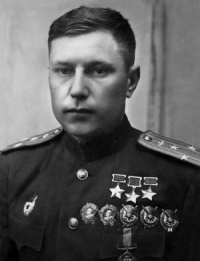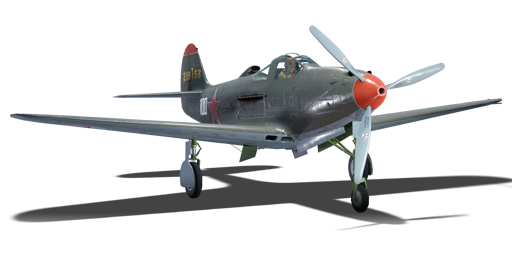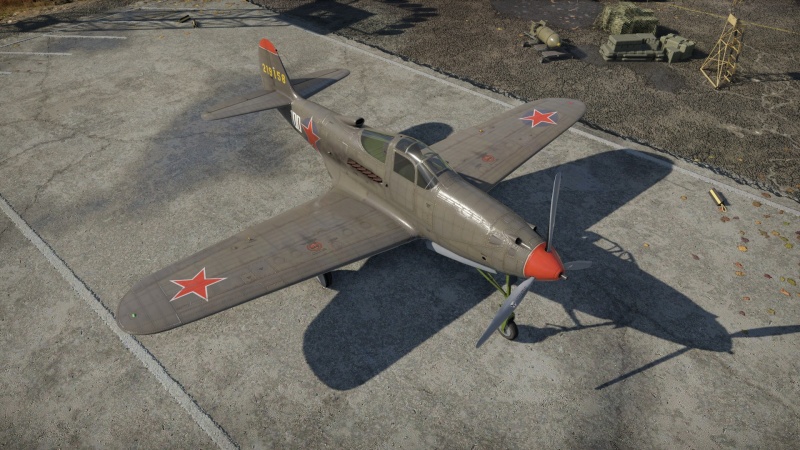Pokryshkin's P-39N-0 (USSR)
| This page is about the gift Soviet fighter Pokryshkin's P-39N-0 (USSR). For the American version, see P-39N-0. For other versions, see P-39 (Family). |
Contents
Description
The ▂Pokryshkin's P-39N-0 Airacobra is a premium gift rank Soviet fighter with a battle rating of (AB), (RB), and (SB). It was introduced in Update 1.31. The plane is painted after the camouflage scheme of Soviet pilot Alexander Pokryshkin in the 16th Guards Fighter Regiment, who scored most of his aerial victories in a lend-lease P-39. It differs from the regular P-39N-0 by the removal of all 4 wing-mounted 0.30 cal machine guns.
General info
Flight performance
The P-39N-0 is a low altitude fighter. Its engine: the Allison V-1710-85 can produce up to 1200 HP, however it has only a single-stage, single-speed supercharger. Because of that, the plane perform well only at low altitude, at sea level it can reach up to 575 km/h and at 3,048 m and it reaches its max level speed at 3,048 m, the level speed there is 644 km/h. Thanks to that it can outperform many other fighters like the early versions of Bf 109 or other American planes at that altitude range. The climb rate performance is decent, getting to 4,500 m should take about 4 minutes when flying with enabled WEP and full fuel tanks, below 1,000 m it is able to reach ~23 m/s. That puts it almost on par with some Bf 109 versions or the Yak-9, but only up to certain altitude. Due to the engine limits after flying for 5 minutes with enabled WEP it might start to overheat, especially with closed radiators. Reducing the propeller pitch to 90-95% and opening its radiators to 15-20% or more will significantly increase the time for how long it can fly at full power.
The manoeuvrability wise the Cobra is a decent plane. It can perform a full horizontal circle at 1,000 m in 18 seconds, but once it climb above the altitude where its engine performs the best the sustained turn rate will be getting worse due to not sufficient amount of power. However even at low altitude it will not be able to outturn any Bf 109E or F version, the P-40F or Yak-9 are also much better at dogfighting. The plane also locks up quite a lot above 600 km/h IAS, although it is very good at diving, its structural speed is 886 km/h, which is excellent compared to the other fighters at similar battle rating. Its roll rate is slightly improved compared to the American N-0 version because of removed wing mounted machine guns, at 400 IAS it can reach ~90°/s and 75°/s at 600 km/h IAS. The turn rate performance can be improved by using flaps, depending on the situation to up to even ~20% at a cost of much higher drag. They can be extended to combat, takeoff and landing position, but their speed limit is quite low, up to 425 km/h IAS, losing them during the fight will significantly decrease its dogfighting capabilities.
In simulator battles the P-39 is a very stable plane, unlike many other propeller driven planes it does not require so much trimming to keep it steady. The stalling characteristics can be violent, it will reaching maximum AoA at ~55% and with combat flaps at 70% of elevator deflection. After pulling it all the way to yourself it will stall out within a few seconds and recovering it from that state will take another few seconds or become almost impossible depending on the fuel loadout (the more fuel, the harder to recover).
| Characteristics | Max Speed (km/h at 3,048 m) |
Max altitude (metres) |
Turn time (seconds) |
Rate of climb (metres/second) |
Take-off run (metres) | |||
|---|---|---|---|---|---|---|---|---|
| AB | RB | AB | RB | AB | RB | |||
| Stock | 614 | 595 | 18.9 | 19.9 | 11.0 | 11.0 | 280 | |
| Upgraded | 682 | 644 | 17.8 | 18.0 | 21.7 | 15.4 | ||
Details
| Features | ||||
|---|---|---|---|---|
| Combat flaps | Take-off flaps | Landing flaps | Air brakes | Arrestor gear |
| ✓ | ✓ | ✓ | X | X |
| Limits | ||||||
|---|---|---|---|---|---|---|
| Wings (km/h) | Gear (km/h) | Flaps (km/h) | Max Static G | |||
| Combat | Take-off | Landing | + | - | ||
| 426 | 396 | 241 | ~13 | ~9 | ||
| Optimal velocities (km/h) | |||
|---|---|---|---|
| Ailerons | Rudder | Elevators | Radiator |
| < 360 | < 380 | < 450 | > 312 |
| Compressor (RB/SB) | ||
|---|---|---|
| Setting 1 | ||
| Optimal altitude | 100% Engine power | WEP Engine power |
| 2,800 m | 1,125 hp | 1,446 hp |
Survivability and armour
- Armour plates
- 15.87 mm (5°) Steel - Propeller hub
- 15.87 mm (15°) - Plate in front of the cockpit
- 7 mm (67°) Steel - Plate over instrument cluster
- 6 mm (5-16°) Steel - Upper pilot's seat and headrest encasement
- 6 mm (5°) Steel - Rear tail
- 38 mm (71°) Bulletproof glass - Windscreen
- 64 mm (5°) Bulletproof glass - Headrest of pilot's seat
- Critical components
- The engine is located behind the pilot
- Cooling systems are under the engine and in the middle of the the tail section.
- Self-sealing fuel tanks are located at the root of each wing.
Modifications and economy
Armaments
Offensive armament
The Pokryshkin's P-39N-0 (USSR) is armed with:
- 1 x 37 mm M4 cannon, nose-mounted (30 rpg)
- 2 x 12.7 mm M2 Browning machine guns, nose-mounted (200 rpg = 400 total)
Usage in battles
Describe the tactics of playing in the aircraft, the features of using aircraft in a team and advice on tactics. Refrain from creating a "guide" - do not impose a single point of view, but instead, give the reader food for thought. Examine the most dangerous enemies and give recommendations on fighting them. If necessary, note the specifics of the game in different modes (AB, RB, SB).
Manual Engine Control
| MEC elements | ||||||
|---|---|---|---|---|---|---|
| Mixer | Pitch | Radiator | Supercharger | Turbocharger | ||
| Oil | Water | Type | ||||
| Controllable | Controllable Not auto controlled |
Controllable Not auto controlled |
Controllable Not auto controlled |
Separate | Not controllable 1 gear |
Not controllable |
Pros and cons
Pros:
- Great acceleration and great top speed in dive
- Decent climb
- Great top speed at sea level
- Decent roll rate
- Decent vertical and horizontal manoeuvrability
- 37 mm cannon does a lot of damage when hitting enemy aircraft
Cons:
- Rudder stiffens at high speed
- 37 mm cannon has slow velocity which makes it hard to aim
- Poor high altitude performance
History
In-game description
Bell's P-39 Airacobra was a WWII-era American fighter that was notable for its uncommon design: the engine was placed behind the cockpit, and the landing gear moved from the tail to the nose. The aircraft was adopted by five countries: USA, Britain, Soviet Union, Portugal and Australia.
The P-39N was the first variant to be mass produced, with the P-39N-0 getting a new V-1710-85(E19) engine and a 3-blade Aeroproducts propeller with a 3.15 meter diameter. Starting from aircraft #167, some fuel tanks were removed from the wings to reduce weight, and a connection for additional fuel tanks was installed under the hull. To further increase flight performance, Soviet engineers often removed the wing-mounted machine guns, leaving two nose machine guns and a cannon.
As this variant, Bell produced 2,095 aircraft. Most of these were sent to the Soviet Union on the US's Lend-Lease program. In November 1942, the USSR received the first Airacobras, and the fighters showed good results in battle maneuvers at low and moderate altitudes. Many famous Soviet aces — such as Pokrishkin Alexander Ivanovich, Rechkalov Gregory Andreevich, Gulaev Dmitry Nikolaevich and Kutakhov Pavel Stepanovich — piloted the Airacobras during WWII.
Notable pilots
-
 Alexander Pokryshkin changed to the P-39N aircraft after his P-39K was damaged by an Il-2 which inadvertenly fired its guns during a rough landing.
Alexander Pokryshkin changed to the P-39N aircraft after his P-39K was damaged by an Il-2 which inadvertenly fired its guns during a rough landing.
Media
- Skins
- Videos
See also
Links to the articles on the War Thunder Wiki that you think will be useful for the reader, for example:
- reference to the series of the aircraft;
- links to approximate analogues of other nations and research trees.
External links
| Bell Aircraft Corporation | |
|---|---|
| Aircraft | |
| Fighters | P-39N-0 · P-39Q-5 |
| P-400 | |
| P-63A-10 · P-63A-5 · P-63C-5 · ␠Kingcobra | |
| Jet Fighters | P-59A |
| Export | ▂P-39K-1 · ▂Pokryshkin's P-39N-0 · ▂P-39Q-15 · ▄P-39Q-25 |
| ▂P-63A-5 · ▂P-63A-10 · ▂P-63C-5 · ▄P-63C-5 | |
| Helicopters | |
| Attack | AH-1F · AH-1G · AH-1Z · AH-1W |
| OH-58D | |
| Utility | UH-1B · UH-1C · UH-1C XM-30 |
| Export/Licensed | ▅UH-1B · ◄UH-1D |
| Tzefa A · Tzefa B · Tzefa D/E · ▅AH-1S early · ▅AH-1S · ▅AH-1S Kisarazu · ␗AH-1W | |
| ␗OH-58D | |
| See Also | Fuji Heavy Industries · Agusta |
| USSR fighters | |
|---|---|
| I-15 | I-15 WR · I-15 M-22 · I-15 M-25 · I-15bis · Krasnolutsky's I-15bis |
| I-153 M-62 · Zhukovsky's I-153-M62 · I-153P | |
| I-16 | I-16 type 5 · I-16 type 10 · I-16 type 18 · I-16 type 24 · I-16 type 27 · I-16 type 28 · I-180S |
| I-29 | I-29 |
| I-185 | I-185 (M-71) · I-185 (M-82) |
| I-225 | I-225 |
| ITP | ITP (M-1) |
| MiG-3 | MiG-3-15 · MiG-3-15 (BK) · MiG-3-34 |
| LaGG | I-301 · LaGG-3-4 · LaGG-3-8 · LaGG-3-11 · LaGG-3-23 · LaGG-3-34 · LaGG-3-35 · LaGG-3-66 |
| La | La-5 · La-5F · La-5FN · La-7 · Dolgushin's La-7 · La-7B-20 · La-9 · La-11 |
| Yak-1/7 | Yak-1 · Yak-1B · Yak-7B |
| Yak-3 | Yak-3 · Eremin's Yak-3(e) · Yak-3P · Yak-3T · Yak-3U · Yak-3 (VK-107) |
| Yak-9 | Yak-9 · Yak-9B · Golovachev's Yak-9M · Yak-9T · Yak-9K · Yak-9U · Yak-9UT · Yak-9P |
| Other countries | ▂P-40E-1 · ▂P-47D-27 · ▂Hurricane Mk IIB · ▂Fw 190 D-9 · ▂Spitfire Mk IXc |
| P-39 | ▂P-39K-1 · ▂Pokryshkin's P-39N-0 · ▂P-39Q-15 |
| P-63 | ▂P-63A-5 · ▂P-63A-10 · ▂P-63C-5 |
| USSR premium aircraft | |
|---|---|
| Fighters | Krasnolutsky's I-15bis · I-16 type 28 · Zhukovsky's I-153-M62 · I-153P · I-180S · I-301 · ITP (M-1) |
| LaGG-3-4 · LaGG-3-23 · LaGG-3-34 · Dolgushin's La-7 · La-11 | |
| Eremin's Yak-3(e) · Yak-3 (VK-107) · Yak-3T · Golovachev's Yak-9M | |
| ▂P-39K-1 · ▂Pokryshkin's P-39N-0 · ▂P-39Q-15 · ▂P-40E-1 · ▂P-47D-27 · ▂P-63A-5 · ▂P-63A-10 · ▂P-63C-5 | |
| ▂Hurricane Mk IIB · ▂Spitfire Mk IXc · ▂Fw 190 D-9 | |
| Twin-engine fighters | I-29 |
| Jet fighters | Su-11 · MiG-15bis ISh · MiG-17AS · MiG-21S (R-13-300) · MiG-23ML |
| Strike aircraft | IL-2M "Avenger" · IL-2 M-82 · IL-8 (1944) · Su-6 · Tandem MAI · TIS MA · Su-8 · Tu-1 |
| Yak-38 · Su-7BMK · Su-25K · Su-39 | |
| Bombers | Po-2M · Be-6 · MBR-2-M-34 · Pe-2-205 · TB-3M-17-32 |
| ▂PBY-5A Catalina · ▂Hampden TB Mk I · ▂A-20G-30 · ▂B-25J-30 | |





